The Caribbean is one of the most popular beach vacation destinations in the world, and for good reason. It's a colorful place, with coastlines boasting hues of blue, white, yellow, green and, perhaps surprisingly, black. This, for me, makes black sand beaches one of the best vacation destination spots to uncover
If you’re wondering where to find black sand beaches, they’re sparsely located all around the world. For those who enjoy traveling to hidden locations away from the crowds, this is all the more reason to visit. Here are my top picks of the seven best black sand beaches to explore in the Caribbean.
How Many Black Sand Beaches Are There in the World?
Dotted around the world, there are around 30 black sand beaches with mesmerizing shorelines. In the Pacific, I learned, they spread across locations like Japan, French Polynesia and Hawaii. The last one surprised me. Where are black sand beaches in Hawaii? Turns out, the Punalu’u black sand beach on the Big Island (or Hawaii Island) or Wai’anapanapa Beach Park in Maui, are both known for their stark beauty. You can also find black sand beaches in Greece, Reynisfjara beach in Iceland and, of course, the Caribbean. While their rarity and diversity make them such a phenomenal experience, it’s the reason these beaches — spread so far apart — are black that makes them all the more fascinating.
How Do Black Sand Beaches Form?
Volcanic activity is what causes black sand beaches. As lava touches the ocean water, its incredibly high temperature (around 1200 °C) quickly turns black, cools and cracks, turning into fine sand. Interestingly, black sand beaches can be created in a very short time, while a white sand beach forms when rocks disintegrate from weathering over thousands and sometimes millions of years. Black sand is a rare phenomenon — and truly a sight to see on your next Caribbean vacation.
Many islands in the Caribbean have black sand. The Dominican RepublicDominca, Martinique and Saint Vincent and The Grenadines are among the best islands to visit in the Caribbean for black sand — some of them we’ll visit today. On the mainland, you can also find plenty, from the black sand beaches in El Salvador to the Costa Rica black sand beaches and beyond — it’s no surprise these shores continue to pique the curiosity of travelers searching for an unforgettable black sand experience. So, if you’re wondering, “Where can I find black sand beaches with something extra?” here’s where I’d recommend:
Playa Negra, Puerto Rico
From the small Puerto Rican island town of Esperanza, I hopped on my 4x4 rental and headed south. The 996 winding road took me past small neighborhoods and farms to a clearing where I could see the coast. Then, I took Route 201, and was suddenly driving on a narrow lane deep in the jungle. I saw "Playa Negra" on a lamppost and knew I had found it. There's a trail that takes you to the beach, an easy 8-10 minute walk on a remote path through the forest.


Dominica - One Island, Two Black Sand Beaches
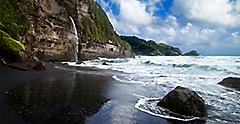

The Coconut Beach Hotel was close by and featured a small restaurant and bar. I walked over and ordered a mango salad and a glass of Kubuli, the local beer. The bartender casually mentioned that Coconut Beach was not the only black sands beach on Dominica.
He was right. It's called Rosalie Bay, and the sand is very dark with out-of-this-world views. Picture a rugged mountain called Morne Trois Piton touching the sky with hundreds of palm trees, sitting along the shore. The sand is black with aquamarine shades dancing across the water. It was totally deserted, surrounded by a dense and humid jungle, which only added to the mystique. I headed to the water and jumped in, coming face to face with a green sea turtle. The sea turtle peacefully floated there for a second, looking into my eyes, then slowly turned and swam away. I felt like I was let in on a beautiful secret.
The remarkable Rosalie Bay Beach is one of my favorite discoveries, and I’ve heard it rivals the famous black sand of places like Punalu’u Beach on a Hawaiian island, where hawksbill and green sea turtles make appearances.
Black Beach Bay, Grenada

If you’re looking for black sand beaches with something extra special, try Black Bay Beach in Grenada. I took the Concord main road and looked for the signs, along the street. Once I found the trail, I hiked about half an hour until I came upon the secluded beach, located in the parish of St. John. The beach featured skinny palm trees and robust tropical trees, the sand marbled with shades of black and gray. There were streaks of black sand that swirled, leading straight to the ocean, submerging under the waves and reaching the bottom of the sea. I found this beach one of the most relaxing spots on the island and was surprised to learn the black sand was only one of many attractions here.
Throughout the day, I watched as people wander in and out of a cave, peeking out of the stone walls. I followed a group inside, where a fellow traveler gestured for me to look up at the cave wall. I saw what looked like minimalist drawings. "Those are ancient Amerindian markings," they explained. "This beach kept getting better and better".
Grenada made me realize that there's so much more beyond the black sand that makes these beaches so special.
Anse Chastanet, St. Lucia
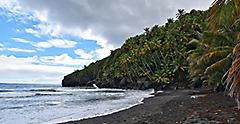
Does St. Lucia have black sand? Absolutely. The Anse Chastanet black sand beach titillates the senses with views of fantastical peaks, giant tropical plants and emerald green waters caressing the dark shore. Getting here from Soufriere is easy; the hard part is leaving. The view of the Pitons, one of UNESCO's natural World Heritage sites, will make you want to relocate here.
It truly is one of the best places to visit in the Caribbean.
Make sure you bring along your snorkeling gear, or rent it nearby. Then, be ready to be wowed by the colorful underwater world of Anse Chastanet Reef, a place teeming with marine life and coral reefs — some of the most vibrant and thriving reefs I have seen in all of the Caribbean while on vacation. It's easy to reach, too, with beach access. Look for the buoyed-off area protected with "no boats" signs. Once underwater, dozens of fish put on a show. I spotted needlefish, trumpet fish, peacock flounders, and puffers, as well as seahorses, sea urchins and sea turtles. I fell in love with the variety of sea sponges. I knew that if I hadn't gone searching for that black sand beach, I wouldn't have discovered this wonderful reef. It made me want to explore more.
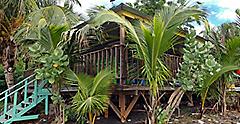
Plage Bananier, Guadeloupe
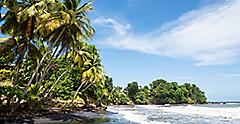
My black sand beach adventure took me to Guadeloupe, specifically a strand of sand called Plage Bananier on Basse-Terre. This wildly beautiful beach has extremely dark sand, darker even against the bright green forest and vibrant waters. I rented a longboard to go swimming and surf the gentle waves. In between waves, I would wade in the water, looking out to the shore where children were building a sandcastle, gothic -looking in its dark shade.
I took a break from the surf and sat by the shore to watch the waves coming and going. Even up close, my eyes could not adjust to this phenomenon. I studied the sand covering my hands closely, shimmering like thousands of tiny diamonds. I joined the children on the beach to help them build their sandcastle. By the afternoon, we were all covered in the sand from head to toe, shining like diamonds ourselves.
Black Beach Point, Saint Vincent And The Grenadines
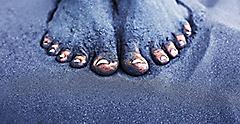
So, where are the beaches that have black sand in Saint Vincent and the Grenadines? Let’s head to Beach Black Point, a favorite of several locals in St. Vincent. Coral reefs are found everywhere on this beautiful beach, and several divers and snorkelers were enjoying the underwater scene. On the other side of the beach, there’s a jungle. Ringing with birdsong, it was denser than I expected. I walked along the treeline, peeking in to see if there were any other surprises to uncover, and I was happy to come across the mouth of a tunnel.
The Black Point Tunnel, built in 1815, has a dark history. It was built by enslaved people to transport products — namely sugar — from the different plantations in Kingstown, the capital. The tunnel is short, but tours are available to learn more about the area's history.
Woodlands Beach, Montserrat
For my last beautiful black sand beach experience, I headed to famous Montserrat — a destination with an active volcano called Soufriere Hills volcano. This volcano wiped out the former capital of the island, Plymouth, in 1995 and turned it into a ghost town or modern-day Pompeii, with houses and buildings preserved under the volcanic debris. This eruption created a black sand beach, called Woodlands Beach. I drove to the west coast to find this remnant from the eruption and encountered what is perhaps the blackest beach of all. Two giant cliffs frame the beach, and the waves cannot intense watery desert of black sand.
I was, again, the only person onin this mythical-looking space, and I buried my feet in the dark sand, thrown off-balance by the coal color around me. When sunset came and, I was still there. My skin, a golden hue, positively glimmered against the carbon black sand.
Get Royal Deals, Sign Up Today

Getting There
Explore Our Most Affordable Itineraries
Black sand this stunning doesn’t stay a secret for long. Book your Caribbean cruise now and see these rare volcanic beaches before the footprints wash away.





